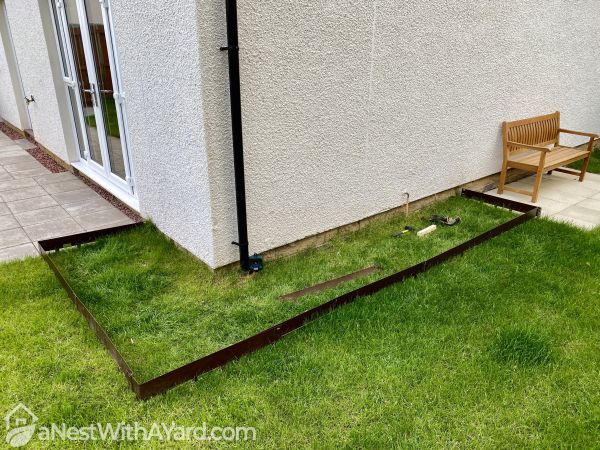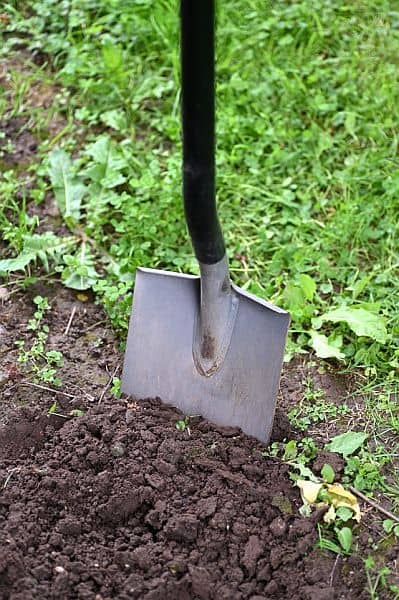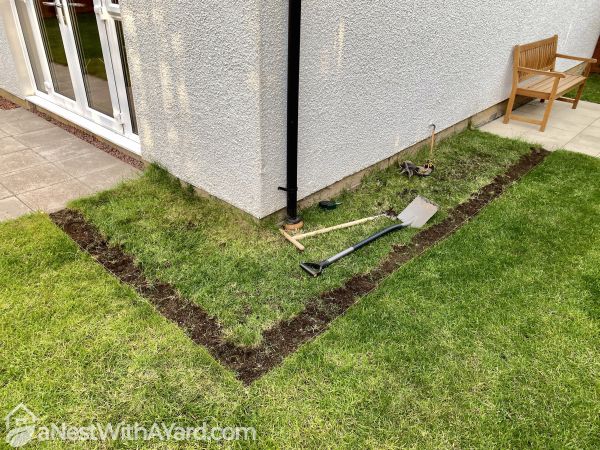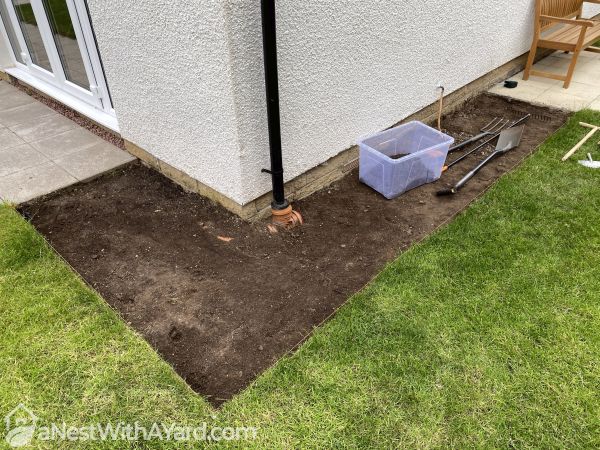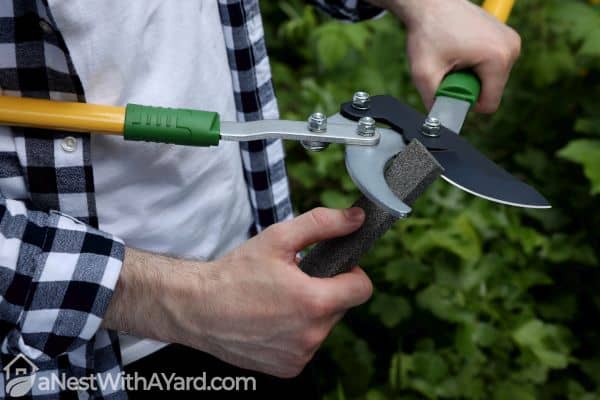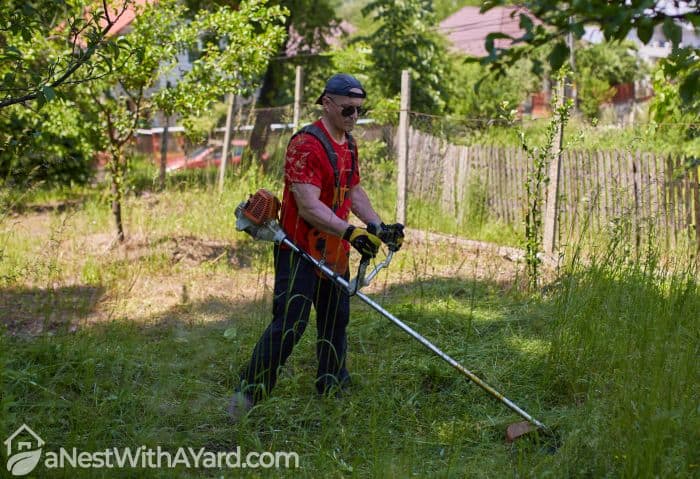Don’t know how to edge a lawn manually? You don’t have to buy an edger to keep your lawn edges neat. Use these 3 ways to edge a lawn without an edger:
- Use a flat head shovel.
- Use edging shears.
- Use a string trimmer, aka weed wacker.
How amazing does this lawn look? Its edges are neat and well-defined. You, too, can achieve the same look with your lawn by following my step-by-step tutorials on how to edge a lawn without an edger.

You heard it right! You don’t have to buy any fancy tools to keep lawn edges neat. Just your trusty old shovel!
I am all about being resourceful and finding new ways to use tools that I already own. I love giving my old equipment a new purpose. This allows me to maintain curb appeal on a budget.
I want to teach you how to trim edge of lawn manually so you, too, can have a picture-perfect lawn for less!
Let’s get right to it!
Contents
3 Ways How To Edge A Lawn Without An Edger
How To Edge A Lawn With A Shovel
Things You Will Need
- A flat-head shovel or spade
- String and spray paint
- Gardening boots
- A broom
- A bucket or a tub
Steps
Here are the steps on how you can edge your lawn using a shovel:
- Mark The Border
The first thing you need to do is mark the border of your lawn so you will know exactly where to push in the shovel to create a new lawn edge. This will ensure your lawn edge comes out straight and not wonky.You can mark the perimeter with a piece of string or some spray paint. Here’s how you do it:Insert two short sticks into the ground along the edge of your lawn. Tie each end of the string to one of the sticks. Now do this on every side of your lawn where you will be edging.The string method is more suited for marking lawns with straight borders. If your turf has curved sides, you can use spray paint to plan out the edges.I recommend you mark your intended new edges, no matter which manual edging method you use from my list. These markings will ensure precision during your work. - Pick The Right Shovel
A shovel is one of the best gardening tools you can own! You can’t have too many.
But which one is best for edging your lawn? You will achieve the best results if you use a flat shovel or a spade with a straight edge. A flat-head shovel cuts at the same depth across the whole length of the blade, unlike a pointed shovel, so you are guaranteed to dig evenly.
Also, make sure the shovel you are using has a straight footrest and a comfortable handle. Use gardening gloves to protect your hands from blisters if need be.
If you don’t have a shovel in your storage that fits this description, I highly recommend you buy an edging shovel. It is specifically designed for this purpose. - Dig The Edge
Now you can finally use the shovel to define the edge of your lawn. Align the flat side of the shovel with the marked border. Hold it vertically, so you can cut straight down into the sod. You shouldn’t hold it at an angle like you are used to when scooping things up. Push the shovel 2 inches into the ground by stepping firmly on the footrest. Then, lift the soil up to remove the dirt. Move the shovel along the marked line bit by bit, say by half the width of the cutting blade at a time. Push it in the ground again. By removing only half the width at the time, you will dig at a consistent depth. Check out this video. It shows a slightly different shovel edging technique:https://youtu.be/hBgqBC4EIxQ - Clean Up The Dirt
All that is left to do is clean up the excess dirt and tidy the edges of your lawn. Clean up the soil that got onto your driveway, pathway, and sidewalk using a broom and a bucket. And you don’t have to throw the collected dirt away. Use it in your garden or flowerbed.
How To Edge A Lawn With Shears
What You Will Need
- Edging shears or grass shears
- A rake
- A bucket
Steps
Meanwhile, here’s how you can edge a lawn using shears:
Pick The Right Shears For The Job
The first thing you need to do is pick the right shears for manual edging. If you own grass shears, you can use these to trim the grass hanging over the lawn edge. If you don’t have any, you can buy edging shears that are specifically designed for this landscaping task.
Edging shears have long handles, which let you work standing up. The blades of the edging shears lay flat against the edge of your cutting area and not on the top of the lawn, like other kinds of shears. This positioning ensures a better cutting angle.
If you don’t own either of these types of landscaping shears, you can try using hedge shears instead. Who knows, they may work just fine! But be prepared to spend hours working in a bent position. This will be hard on your knees and your back.
Prep The Shears
If your edging shears have been sitting in your shed for a long time, you will need to prep them first. Check the sharpness of the blades and see how they open. Dull shears won’t get you far. Sharpen them and grease them with oil if they are rusty. If you need help, here’s a video guide just for you: https://www.youtube.com/watch?v=EegJ5SVdErc&t=29s
Cut The Grass Growing Over The Edge
Edging shears can’t remove the excess soil from the edge of the lawn. They are used for cutting the excess grass that is spilling over the lawn border and for maintaining an already edged lawn. Edging shears are pretty simple to use. Put the blades against the edge of your lawn and start snipping the overgrown grass. Cut the grass with swift motions to get a better cut. If you snip too slowly, you will only bruise the grass. Try to keep a steady hand while cutting to maintain an even cut.
Rake Up The Grass Clippings
Once you are finished cutting the excess grass, you can go ahead and rake up the clippings. Collect them in a bucket and add them to your compost pile. You are all done!
How To Edge A Lawn With A String Trimmer
What You Will Need
- String trimmer aka weed wacker
- String and spray paint
- Safety goggles
- Gardening gloves
- Gardening boots
- Ear protection
Steps
Lastly, try edging your lawn with a string trimmer using these steps:
Mark The Border
The first thing you need to do is mark the border of your lawn. You can outline your lawn with a string or spray paint, as I mentioned above. Run the string alongside straight edges of your lawn and mark curved sides with spray paint.Read the first step of the first tutorial for a detailed explanation.
Protect Yourself
Before you start your string trimmer, you need to protect yourself. Put on some non-slip gardening or construction boots that will protect your toes. Wear safety goggles to shield your eyes from flying grass clippings. We all know that gas string trimmers are pretty loud. Your neighbors sure know, anyway. All jokes aside, you should wear ear protection since prolonged exposure to loud noise leads to hearing loss.
Prep Your String Trimmer
The last thing you want is your string trimmer dying on you in the middle of the job. Before you start edging your lawn, fill up the tank with fresh gasoline. Give it a test run. If the trimmer is running smoothly, you can start working on your lawn.
Use Your String Trimmer
Image credit: blackanddecker.com Hold the string trimmer perpendicular to the lawn, at a 90-degree angle, as seen in the photo above. Don’t hold it parallel to the ground like you are used to. Keep it about 4 inches above the ground and run it along your marked line. The rotating string should cut through the grass and soil to create a clean edge. Continue trimming the edge along the marked border. One of the perks of using a string trimmer is speed. You will quickly finish the job and you may even have some spare time to try these lawn edging ideas. They sure look pretty! Here’s a video that shows how you edge a lawn with a string trimmer:youtube.com/watch?v=8nuhUElzQR8
Clean Up The Site
Once you are done using your string trimmer, you can start cleaning up the yard debris. Remove grass clippings and dirt from the lawn. Don’t forget to sweep your driveway and other paved surfaces too! You want to define the new edge of your lawn and make it noticeable.
Don’t throw the collected debris away! Add it to your garden bed or composting pile.
FAQs
Do you really need an edger?
You don’t really need an edger unless you are changing the shape of your lawn and want to achieve a professional look. You can edge your lawn with a string trimmer, edging shears, or a shovel too!
What can I use instead of an edger?
You can use a string trimmer instead of an edger. Hold it perpendicular to the lawn and run it alongside your lawn border. You can also use edging shears, an edging shovel, and a spade to define the edge of your lawn.
That’s How To Edge A Lawn Without An Edger
See? You can keep your lawn edges neat at all times with basic tools you already own. You don’t have to buy an edger to make your backyard presentable. Try my manual edging methods listed above. I am sure you will find one that works for you!
I wanted to share these tutorials to encourage you and others to be more creative and resourceful in your landscaping and gardening ventures.
Did you like my tutorial on how to edge a lawn without an edger? Let me know in the comments below, and feel free to share them on your social media.
